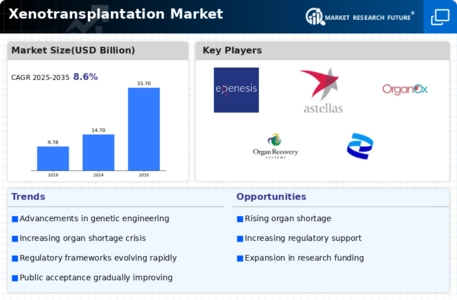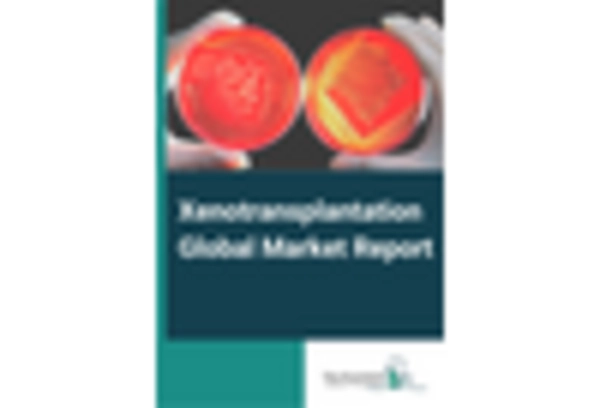Increasing Organ Shortage
The persistent shortage of available organs for transplantation is a critical driver for the Xenotransplantation Market. As the demand for organ transplants continues to outpace supply, the need for alternative sources becomes increasingly urgent. Reports indicate that over 100,000 individuals are currently on waiting lists for organ transplants, with many facing dire health consequences due to the lack of suitable donors. This scarcity propels research and development in xenotransplantation, as it offers a potential solution to alleviate the burden on traditional organ donation systems. The Xenotransplantation Market is thus positioned to grow as healthcare providers and researchers explore the viability of using genetically modified animal organs to meet the rising demand.
Public Perception and Acceptance
Public perception and acceptance of xenotransplantation are crucial factors influencing the growth of the Xenotransplantation Market. As awareness of the potential benefits of xenotransplantation increases, there appears to be a gradual shift in public opinion. Educational campaigns and outreach efforts are essential in addressing ethical concerns and misconceptions surrounding the use of animal organs for human transplantation. Surveys indicate that a significant portion of the population is open to the idea of xenotransplantation, particularly when informed about the potential to save lives. This growing acceptance may lead to increased support for research initiatives and funding, thereby propelling the Xenotransplantation Market forward.
Regulatory Support and Frameworks
The establishment of supportive regulatory frameworks is a pivotal driver for the Xenotransplantation Market. Governments and regulatory bodies are increasingly recognizing the potential of xenotransplantation as a viable alternative to traditional organ transplantation. Initiatives aimed at streamlining the approval process for xenotransplantation products and procedures are being developed, which may enhance the speed at which new therapies can be brought to market. For instance, the U.S. Food and Drug Administration has initiated discussions on guidelines specific to xenotransplantation, indicating a shift towards a more favorable regulatory environment. This support is likely to encourage investment and innovation within the Xenotransplantation Market, ultimately benefiting patients in need of organ transplants.
Rising Incidence of Chronic Diseases
The increasing prevalence of chronic diseases, such as diabetes and heart disease, is driving demand for organ transplants and, consequently, the Xenotransplantation Market. As these conditions become more common, the need for organ replacements is expected to rise. Data suggests that chronic diseases account for approximately 70% of all deaths worldwide, highlighting the urgency for effective treatment options. The Xenotransplantation Market stands to benefit from this trend, as it offers a potential solution to the growing number of patients requiring organ transplants. The intersection of chronic disease prevalence and the limitations of current organ donation systems may catalyze further research and development in xenotransplantation.
Technological Advancements in Biotechnology
Technological innovations in biotechnology are significantly influencing the Xenotransplantation Market. Recent advancements in gene editing techniques, such as CRISPR-Cas9, have enabled scientists to modify animal genomes to reduce the risk of organ rejection and enhance compatibility with human recipients. These breakthroughs not only improve the safety and efficacy of xenotransplantation but also stimulate investment in research and development. The market is witnessing a surge in funding, with estimates suggesting that the biotechnology sector could reach a valuation of over 700 billion dollars by 2025. This influx of resources is likely to accelerate the pace of innovation within the Xenotransplantation Market, fostering new solutions to address organ shortages.


















Leave a Comment